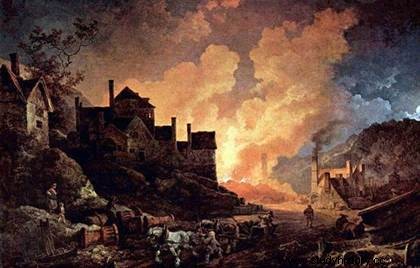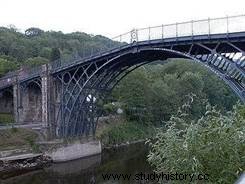 Symbol of the first English industrial revolution , Coalbrookdale, by night (1801) was painted by the French painter Philippe-Jacques de Loutherbourg (1740-1812). The artist's most famous and most reproduced painting, this oil on canvas is not very representative of his work. The theme of this painting, the industrial revolution, is not original for the time and has inspired many other artists such as William Williams (1777), Anna Seward (1785) or Joseph Mallord Turner (1797). Yet this painting by a largely unknown painter is the one that has most deeply marked people's minds and has best survived the centuries.
Symbol of the first English industrial revolution , Coalbrookdale, by night (1801) was painted by the French painter Philippe-Jacques de Loutherbourg (1740-1812). The artist's most famous and most reproduced painting, this oil on canvas is not very representative of his work. The theme of this painting, the industrial revolution, is not original for the time and has inspired many other artists such as William Williams (1777), Anna Seward (1785) or Joseph Mallord Turner (1797). Yet this painting by a largely unknown painter is the one that has most deeply marked people's minds and has best survived the centuries.
The painter, Philippe-Jacques de Loutherbourg
"Painter of landscapes evoking a sublime and threatening nature, painter of history with romantic overtones", this largely unknown painter has only been the subject of two exhibitions so far. day. A pupil of Charles André van Loo and then of Casanova, he became painter to Louis XV in 1766 and entered the Royal Academy of Painting and Sculpture the following year. He was acclaimed very early on by the Parisian public and by Diderot in particular. In 1771, following personal problems, he moved to London and became a theater decorator.
A few years later, he invented a mechanical theater, the Eidophusikon. He does not abandon painting, however. His successes in London opened the doors of the Royal Academy to him. in 1781. His vast and eclectic work was appreciated although much criticized by his contemporaries. However, his eventful life contributed to his eclipse during his lifetime. Between scabrous scandals and passion for the occult sciences, he continued despite everything to paint until the end of his life. His pictorial work (essentially landscape paintings) foreshadows the Romantic movement, although he painted more academic paintings. It was towards the end of his life, a few years before falling seriously ill, that he painted the picture, quite apart from his work, which is discussed in this article.
Cradle of the mining and metallurgical industry
The Abraham Darbys are a line of Quakers whose role was instrumental in the industrial revolution. This modest family of blacksmiths left Bristol and settled in Coalbrookdale in 1709 due to the presence of iron and coal nearby. Throughout the 18th century, she perfected the technique of coke casting (the first dates from 1709). The industrial revolution was born from the empirical experiments of modest families like the Abraham Darbys who did not have significant capital:we are far from the large factories of the second industrial revolution. The refinement of coke pig iron is aided by the continuing rise in the price of charcoal pig iron. However, the latter was favored until the 1750s, as illustrated by the orders of the Board of Ordinance of the Royal Navy . By giving these new technologies a chance. In the 1760s, the Royal Navy allows the development of these and thus had a driving role in the industrial revolution.

Coalbrookdale, a tourist attraction
Coalbrookdale was already a tourist attraction in England in the 18th century thanks to its blast furnaces and its famous Iron Bridge also called Coalbrookdale Bridge which connects the industrial town of Broseley to the mines of Madeley . It is difficult to imagine today what the reaction of contemporaries could have been to such a spectacle.
 "The approach to Coalbrookdale seemed like a veritable descent into hell. A column of dense smoke was rising from the ground quantities of steam were ejected by steam-engines, a blacker cloud issued from a tower which was a forge, and smoke rose from a mountain of hot coals from which came turbid flames. , I went down towards the Severn, which flows slowly between two high mountains then passes under a bridge built entirely of iron. This landscape appears to me like a door of mysteries, and the night already falling, added to the majesty of the scene , which could not be compared with the regions so powerfully described by Virgil."
"The approach to Coalbrookdale seemed like a veritable descent into hell. A column of dense smoke was rising from the ground quantities of steam were ejected by steam-engines, a blacker cloud issued from a tower which was a forge, and smoke rose from a mountain of hot coals from which came turbid flames. , I went down towards the Severn, which flows slowly between two high mountains then passes under a bridge built entirely of iron. This landscape appears to me like a door of mysteries, and the night already falling, added to the majesty of the scene , which could not be compared with the regions so powerfully described by Virgil."
Italian Visitor, 1787, Wolverhampton Chronicle , 1790
The feelings of this Italian tourist are very similar to those that can still be evoked today by the Philippe-Jacques de Loutherbourg painting. This cradle of the industrial revolution left no stone unturned and amazed and fascinated contemporaries.
Today, the landscape is quite different. Less lively, the Ironbridge Valley today brings together many abandoned industrial sites and many museums recalling the past of this place. This set has been listed as a UNESCO World Heritage Site since 1986.
This painting is a reflection of its time:between wonder and curiosity, the beginnings of the first industrial revolution very quickly interested contemporaries. Coalbroodale, de nuit today illustrates and supports many comments on the first industrial revolution and its socio-economic or technological aspects. The painting also illustrates a part of the cultural history of the end of the 18th century. It seems, however, that the author chose this theme more for the artistic effects it could offer the painter in terms of light effects than by attraction to technical novelties, which his immediate contemporaries understood well:Olivier Lefeuvre rightly notes title that it is "the extraordinary effect of contrast which occupies two thirds of the canvas" which is at the heart of the painting.
This contrast allows the painting to have a strong "evocative power" and to inspire the viewer.. Sometimes the work and its reception go beyond its author. Many more or less justifiable readings and interpretations have been formulated. The historico-economic theme is the one that has the greatest success. Although neglecting the artistic aspects, this paradoxically allowed this painting to be still widely known today and to allow its painter not to be totally forgotten.
Indicative bibliography
- LEFEUVRE Olivier, Philippe-Jacques de Loutherbourg, (1740-1812) , Arthena, Paris, 2012
- VERLEY Patrick, The Industrial Revolution , Gallimard, Paris, 1997.
